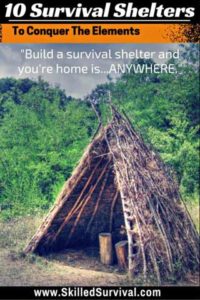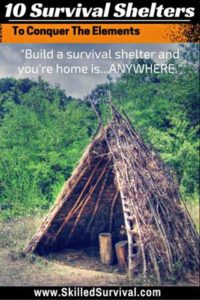Guide To Building, Finding, and Deploying Survival Shelters
There’s more than one way to skin a cat.
And they’re even more ways to find, build and deploy survival shelters.
But only if you know what you’re doing.
In this guide, we show you our 10 favorite simple-to-build ones.
And we don’t just tell you…
We teach you and show you the best how-to videos we could find.
So today I’m going to utilize my Engineering, Outdoors, Survival & Preparedness background to share the following info:
TABLE OF CONTENTS
3 Must-Own Shelter Tools
Best Survival Shelters To Build
Why Learn Shelter Building
Do YOU Live In A ‘Danger Zone’ County?
Find out NOW with my Danger Zone County List & Special Report – It’s 100% FREE… Click here now for Instant Access!
3 Lifesaving Shelter Tools
Emergencies are, by definition, unplanned events:
“A serious situation or occurrence that happens unexpectedly and demands immediate action.”
The most important word here is UNEXPECTEDLY.
You were caught off guard. You didn’t expect the event, but never-the-less, stuff happens.
We cannot prevent all emergency situations from our lives; however, we can prepare for the unexpected.
Or, as they say,
“Expect the unexpected.”
So how do you do this regarding makeshift shelters?
AquaQuest Defender Tarp – 100% Waterproof
By purchasing a tough-as-nails survival tarp and stashing it in your vehicle, or your bug-out bag, your day pack, etc.
I’m often asked which survival tarp I consider “The Best.”
Best is a loaded word, but I like the Aqua Quest Defender Tarp.
It’s 100% waterproof, extremely durable, lightweight, and compact, and it includes over 20 reinforced loops for a versatile setup in any situation.
It’s made of durable 70D nylon with a Heavy TPU coating. Plus, reinforced stitching and heat-taped seams.
No, it’s not a cheap big box store tarp.
Remember, when it comes to survival tarps, you get what you pay for.
↓ AquaQuest Waterproof Heavy-Duty Defender Tarp ↓
Before we move on, one more quick note of caution about cheap tarps:
- Not all tarps are created equal. Cheap tarps rip.
- Cheap tarps don’t have any grommets.
- You need lots of grommets to make all the tarp shelter variations.
- And the cheap grommets tarps do have will rip the tarp under very little tension.
- Cheap tarps will quickly deteriorate under UV light exposure.
- Cheap tarps are not good for survival. Don’t buy cheap tarps.
Don’t do it; get a tarp worthy of survival.
1,000 LB SurvivorCord XT | 100 FEET
And as we’ll cover in more detail shortly, you’ll also benefit from having a bit of paracord with you at all times.
Paracord has many survival uses, but with shelter building, it’s essential for securing tarps and lashing wood together.
And while some paracord is better than others, most will work for building survival shelters.
I recommend getting some SurvivorCord. It’s proven, tough, and ideal for survival.
↓ Tital SurvivorCord Demonstration ↓
TACT Bivvy Emergency Sleeping Bag
Advertised as “one of the most advanced survival tools on the planet,” the Tact Bivvy is an incredible piece of survival gear.
Small enough to fit in your hand, this survival blanket utilizes Mylar. Mylar provides the highest quality, most effective emergency blanket around.
And because it’s taped together, it traps your body heat inside more like a sleeping bag than a blanket.
The Tact Bivvy is the best bang for your buck when you compare weight to warmth. It provides maximum heat with minimal weight.
Making it perfect for bug-out bags, get-home bags, survival packs, or glove boxes.
Not only that, but it is windproof, waterproof, easy to use, and includes a small stuff sack.
This helps keep it stored neatly when you are not using it.
And the best part? It’s affordable. At this price, it’s an accessible survival tool for everyone.
Field Tested
We even tested the Tact Bivvy on a chilly 40-degree overcast day. “Just In Case,” Jack (our managing editor) recorded temperatures inside the Tact Bivvy, and after only 10 minutes, it was a warm 82 degrees.
It was so warm inside the Tact Bivvy that he got out shortly after 10 minutes to keep from overheating.
If it works this well on a cool 40-degree day, it’s a legitimate lifesaver in below-zero survival situations.
The bottom line is – The Tact Bivvy works and is excellent for cold-weather survival.
I recommend you get one for your bug-out bag, one for your medical first aid kit, one for your car, and your home.
↓ Bug Out Bag Shelter – Survival Frog TACT Bivvy Review ↓
So with just these three simple items (a survival tarp, some quality paracord, and a Tact Bivvy) and shelter knowledge, you can protect yourself from even the most severe weather emergencies.
Exclusive Bonus Content – Skilled Survival’s 104 Item Bug Out Bag Checklist – the only bug out checklist worth using. Click Here To Get Your FREE Copy Of It.
10 Best Survival Shelters Ideas For Last Resort Protection
Forest Shelters
We’ll start off with wilderness shelters in a forest setting with little to no snow.
This is the sort of environment many people find themselves stranded in every year.
Whether getting lost on a hike or injured on a hunting expedition, the following forest type of shelter options will keep you protected and alive.
1. The Simple Tarp Shelter
Here’s a video sharing an easy way to build a tarp shelter if you have a high-quality survival tarp with you.
↓ 8 Easy Tarp Shelters for Survival ↓
Now, you can make more elaborate shelters (which we’ll get to shortly), but they require more time and calorie commitment.
You will not build them for a single night in a rare emergency. But a night or two is exactly where the tarp shelter excels.
Here are a couple of key takeaways before we continue.
If you have some extra time and are not minutes from hypothermia or dehydration, you should look for a good base location.
You want the natural surroundings to help reinforce your shelter.
There are good shelter locations and bad locations. Take a few minutes to find a good location.
Also, you need to figure out the prevailing wind direction.
Most of us in the United States will be from West to East. So you’ll want to have the back of the tarp facing to the west.
That way, driving rains and howling winds will be deflected by the tarp.
If you build your shelter’s entrance facing the prevailing winds, the winds will enter and push rain with it into your shelter. Not fun.
Pro tip: Understanding prevailing winds is key for all shelter setups, not just tarp shelters.
2. Stealth Shelters
Here’s a video focusing primarily on stealth camping you can use in an emergency.
↓ 10 Stealth Camping Shelters: Tips and Skills ↓
So as you just saw, each of these designs will keep you HIDDEN, warm, and dry.
You can combine any of these setups with fire if hypothermia concerns you.
Building a one-night shelter becomes more labor-intensive if you don’t have a tarp!
However, it’s worth learning these skills for a worst-case scenario.
Forests offer an abundance of resources you need to build a strong shelter.
Fallen trees provide ample amounts of logs and sticks. They also provide ample pine straws and leaves.
These tree branches are your basic building blocks to many survival shelters.
Note: These shelters won’t work well if these resources are unavailable. You’ll need to check out some of the other shelter options later in this article.
3. The Debris Shelter
This simple frame shelter is your next best bet if you are without a tarp.
Here’s a quick video showing how to build a debris hut shelter.
↓ Survival Skills – Debris Shelter ↓
Now before we move on to more sophisticated shelters, I want to talk about the often overlooked but absolutely simplest shelters; Natural Shelters.
Take advantage of what nature can provide. I’m talking about outcrops, caves, large burrows, or natural depressions.
If you can find a natural area that’s protected from wind and rain, then, by all means, use it. Take what nature gives.
Don’t spend hours or days building a complex shelter when there’s an empty cave nearby.
You’ll want to have a few essential survival tools to make the most of a forest’s resources and build a stable structure.
At a minimum, you need a high-quality survival knife.
And for the more heavy-duty survival shelter builds, you’ll need a Survival Hatchet, a Pocket Chain Saw, Survival Machete, and a Portable Tactical Shovel.
Assuming you have these items, you can construct the following survival shelters with some knowledge and practice.
4. The Japanese Spider Hole Shelter
This long term shelter is ideal for solo survival.
↓ Digging a Japanese Spider Hole (and sleeping in it!!!) ↓
Now, if you stay for the long haul, you might add a few upgrades to this hole over time.
↓ Surviving 24-hrs UNDERGROUND (in the Spider Hole!!!) – Building a Secret Tunnel Bunker ↓
The spider hole shelter is a relatively simple, proven design but takes time and effort to build.
5. The Wickiup Shelter
A Wickiup shelter is more elaborate and will take extra time and energy to build than a debris shelter.
However, you can scale this design to include larger survival groups for long-term stays.
↓ How to Build A Wikiup ↓
Now, if you’re planning an extended stay in a Wickiup, it makes sense to invest some effort in making life a bit more comfortable.
You’ll also have time to upgrade your shelter over the weeks or months you live there.
So here’s a video series with survival shelter ideas on upgrading your wickiup from surviving to thriving.
↓ Pimping Your Shelter Part 1 – Alpine Debris Bed ↓
↓ Pimping Your Shelter Part 2 – Custom Firepit ↓
↓ Pimping Your Shelter Part 4 – Making The Door ↓
And lastly, here’s a video of several bushcraft shelter ideas (which includes the simple lean-to shelter):
↓ 5 Bushcraft Shelter Ideas Everyone Should Know ↓
Jungle Shelters
For emergencies in a jungle, your best bet is a tarp shelter.
If you don’t have one, then you can build a debris shelter similar to the ones we previously covered.
The tree species and debris will differ in a jungle, but the concept is similar.
So let’s move on to my favorite long-term jungle shelter: The Survival Hut.
6. The Survival Hut
Jungles provide unique natural materials you can use to build with. They have thick vines, hollow shoots, and large leaves, and the ground is often made of clay.
Plus, you’ll likely have abundant water available to work with.
A survival hut starts by using the wattle technique to interlace shoots and sticks.
Wattling creates a simple fencing structure. Then you use the duab technique to smear a clay-like substance onto the wattle and allow it to dry.
These two methods create a substantial survival hut.
Now, feel free to use tools to make your hut. But to show you what’s possible, in the next video, the entire hut is built with no brought tools.
He makes tools with just the resources around him.
Worth watching the entire video!
↓ Primitive Technology: Wattle and Daub Hut ↓
Snow Shelters
So far, we haven’t discussed shelters for winter and snow. They don’t work in deep snow.
Forest shelters can still work if they’re trace amounts of snow, but if you’re dealing with multiple feet of snow, you won’t find the wood or debris necessary to build them.
So instead, you’ll need to take advantage of the snow.
7. A Snow Cave
Snow caves work well as emergency survival shelters.
You dig a snowhole and get in. It’s fast, quick, down n’ dirty.
The reason this works is that snow has insulating properties.
So while snow is cold, it also does a fantastic job trapping heat.
So if you dig a hole in the snow and then bundle up inside, the air temperature inside the snow cave will rise over time due to your trapped body heat.
When built correctly, the air temperature inside the snow cave will rise several degrees higher than the outside air temperature.
Plus, it will protect you from the wind, which is the biggest concern in a severe blizzard.
However, be careful when building a snow cave.
There are some dangers you need to be aware of.
First, you need to remain dry at all times.
Avoid extreme sweating while building because wet and cold can lead to a hypothermic situation.
Second, over the years, cooking in a snow cave has been attributed to several mountain climber deaths from carbon monoxide poisoning.
Here’s an article that covers more snow cave dangers.
This video shows you the basics of building a snow cave.
↓ Luxury Snow Cave Build! | How To Dig a Large Snow Cave ↓
Now in an emergency situation where time is of the essence, you wouldn’t make it nearly as large.
Just big enough to get in it fast.
While snow caves are relatively straightforward to build, they’re unsuitable for longer-term situations.
Snow caves will eventually collapse in on themselves.
A full-out collapse typically takes several days of warm weather or rain,
but they are not meant for months of sheltering.
And that’s where the iconic igloo comes in.
7. An Igloo Shelter
By design, igloos are made to last. Obviously, snow melts in warm weather, but the integrity of an igloo (if properly built) is impressive.
Check out this short video to show you how strong and durable igloos are.
↓ Igloo Strength, Stability & Durability – A Demonstration ↓
So how do you correctly build an igloo by yourself?
Here’s a step-by-step video showing you how to build your own survival igloo.
↓ I Built an IGLOO TINY HOUSE ↓
Note: Cold weather survival skills include more than just building snow caves and igloos. Make sure you understand all aspects of cold weather survival.
Next up, the opposite of cold and snow; heat and desert.
Desert Shelters
Desert survival takes a unique set of skills.
Many people make the mistake of thinking a shelter isn’t necessary for a desert.
↓ Deserts 101 | National Geographic ↓
They think “it doesn’t get cold in a desert,”; which is false.
Deserts at night can get brutally cold. For example, America’s most infamous desert, “Death Valley,” often drops into the ’30s over the winter months.
And many people also forget about the need for shade in the heat of the day.
This article points out the large differences between temperatures in the shade vs. direct sunlight.
So while it’s blistering hot during the day, you need a shelter to help shade you from the sun.
But as evening sets in, you’ll need shelter to keep you warm.
The bottom line is you need shelter in a desert survival scenario.
So it’s best to learn how to make one.
Now, if you’re stranded in the desert due to a broken-down vehicle, then you already have a decent shelter; the vehicle itself.
So in most cases, it makes the most sense to stay with your vehicle instead of abandoning it.
There are exceptions, but if you’re stranded, lost, and hoping for rescue, use your vehicle’s inside as your desert survival shelter.
If you’re stranded on foot, a good tarp will work wonders in a short-term desert survival situation, but if you don’t have a tarp with you, you will have to improvise.
You’ll have to use what the environment gives you.
The desert often means miles and miles of juniper trees and sagebrush.
9. A Juniper Tree Shelter
Here’s a video showing how to use a Juniper Tree to improvise a shelter in the desert.
↓ Desert Shelter – Improvised Juniper Tree Shelter ↓
10. Dug Out Shelter
And for a long-term survival stay, you could build a dugout shelter in a sandy area of the desert like this one:
↓ Modified Dugout Shelter ↓
Of course, this one takes quite a lot of work, so if you plan on building this sort of shelter in a desert, you’ll want a survival shovel and plenty of water available.
Otherwise, you’ll quickly suffer from dehydration.
You also need to think carefully about the location of a dugout shelter.
Flash floods in the desert are extremely dangerous.
The last thing you want to do is build a dugout shelter in a washout basin.
↓ Amazing Flash Flood | Debris Flow Southern Utah HD ↓
Why You Should Learn How To Build A Shelter
I love the great outdoors, but I hate feeling exposed.
Wait, don’t those two statements contradict each other?
Yes, they do if you don’t know how to build a survival shelter.
But if you can build one…then the answer is: No.
Let me explain…
Riding out Mother Nature’s worst without shelter is not only a crappy time; it’s also deadly.
When unprepared humans go up against extreme weather, weather wins.
And even if the weather conditions “play nice,” knowing how to build a safety barrier between you and the rest of the world is comforting.
Cold, wet, heat, and dangerous animals all reduce your chances of survival.
And at the extremes (blizzards, torrential downpours, heat waves, and attacks), you’re survival window slams shut.
So if you can’t build, find or deploy a shelter in the harshest conditions, you’re done for in mere minutes.
That’s why sheltering is essential to survival.
Whether you’re planning a bug-out or want to be ready for an unexpected emergency, everyone should learn to build, find, and deploy shelters.
Now before we continue:
Different Shelters For Different Environments
Not all shelter designs work in all environments.
For example:
A good forest shelter will not work in deep snow or the hot desert.
So I’ll also break this article into the following categories as well:
- Forest Shelters
- Snow Shelters
- Jungle Shelters
- Desert Shelters
So let’s start things off with the simple lifesaving emergency shelter tools.
Because you should never make survival harder than it needs to be.
Final Thoughts
It’s time to get outside!
No matter what environment you live in or what season it is right now, you can build yourself one of these survival shelters.
Practice making them in a safe location today when you’re not under extreme stress.
Make them close to home, where the consequences of a screw-up are not life-threatening.
Practice makes perfect, and mistakes help you learn.
Ensure you’re making safe mistakes before putting your skills to the test.
Also, as discussed at the beginning of this article, get a survival tarp and paracord to help make your shelter builds easier.
Also, invest in lifesaving Tact Bivvy.
Then add these tools to your car emergency kits, day packs, get-home bags, and bug-out bags.
I always keep all these tools with me, just in case, and you should too.
Prepare, Adapt & Overcome,
P.s. Do You Live In A ‘Danger Zone’ County?
Find out now using my Danger Zone County List & Special Report it’s absolutely FREE.
In minutes you’ll know EXACTLY where you stand and if you should be worried or not..
So click here to get my FREE Danger Zone County List & Report….
Click on the image to get the List & Report for FREE and find out if YOU live in a ‘Danger Zone’ County…”
The post 10 Best Survival Shelter Ideas For Surviving The Harshest Of Elements appeared first on Skilled Survival.













